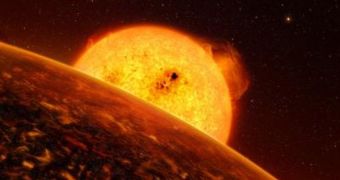Astronomers at the European Southern Observatory (ESO) finally concluded the largest set of HARPIS measurements, and established the mass and density of the smallest and fastest orbiting exoplanet known, CoRoT-7b. The celestial body has a mass five times that of our own planet, and a radius about two times bigger, which can only mean that it too is rocky, with a consistency very similar to this one's. The same solar system also revealed a new so-called Super Earth, orbiting within its recesses.
“This is science at its thrilling and amazing best. We did everything we could to learn what the object discovered by the CoRoT satellite looks like and we found a unique system,” Didier Queloz, the leader of the ESO team in charge of the new observations, says. The Earth-like exoplanet revolves around a once-thought-unremarkable star formerly known as TYC 4799-1733-1. Once the planet was found, the star was renamed CoRoT-7. It is located towards the constellation of Monoceros (the Unicorn), at a distance of about 500 light-years, and its age is estimated to be of about 1.5 billion years.
The planet completes one swing around CoRoT-7 in 20.4 hours. When this interval is met, astronomers can notice a slight dimming in the brightness of the parent star, which lasts for about one hour, and is equivalent to 1 in 3,000 parts. Starspots, however, made accurate estimates of the exoplanet's properties difficult, so experts turned to the High Accuracy Radial velocity Planet Searcher (HARPS) spectrograph, attached to the ESO 3.6-meter telescope at the La Silla Observatory, in Chile.
“Since the planet's orbit is aligned so that we see it crossing the face of its parent star – it is said to be transiting – we can actually measure, and not simply infer, the mass of the exoplanet, which is the smallest that has been precisely measured for an exoplanet. Moreover, as we have both the radius and the mass, we can determine the density and get a better idea of the internal structure of this planet,” Claire Moutou, an ESO team member, adds.
It was also determined that CoRoT-7b orbited its star at a speed of 750,000 kilometers per hour, which is about seven times faster than the speed of the Earth around the Sun. The planet is only 2.5 million kilometers away from its sun, or roughly 23 times closer than Mercury is to our own star. “In fact, CoRoT-7b is so close that the place may well look like Dante's Inferno, with a probable temperature on its 'day-face' above 2,000 degrees and minus 200 degrees on its night face. Theoretical models suggest that the planet may have lava or boiling oceans on its surface. With such extreme conditions this planet is definitively not a place for life to develop,” Queloz concludes.

 14 DAY TRIAL //
14 DAY TRIAL //